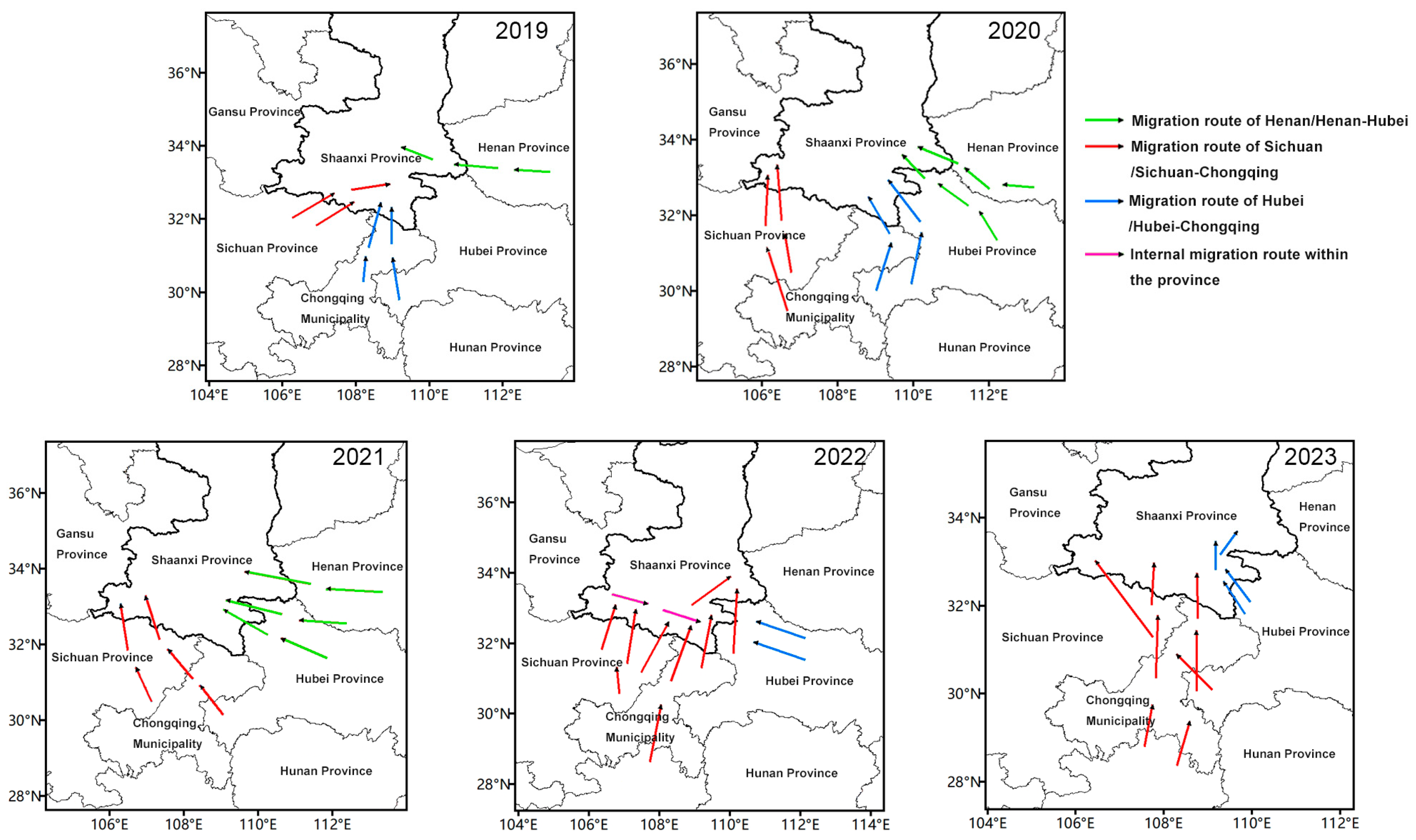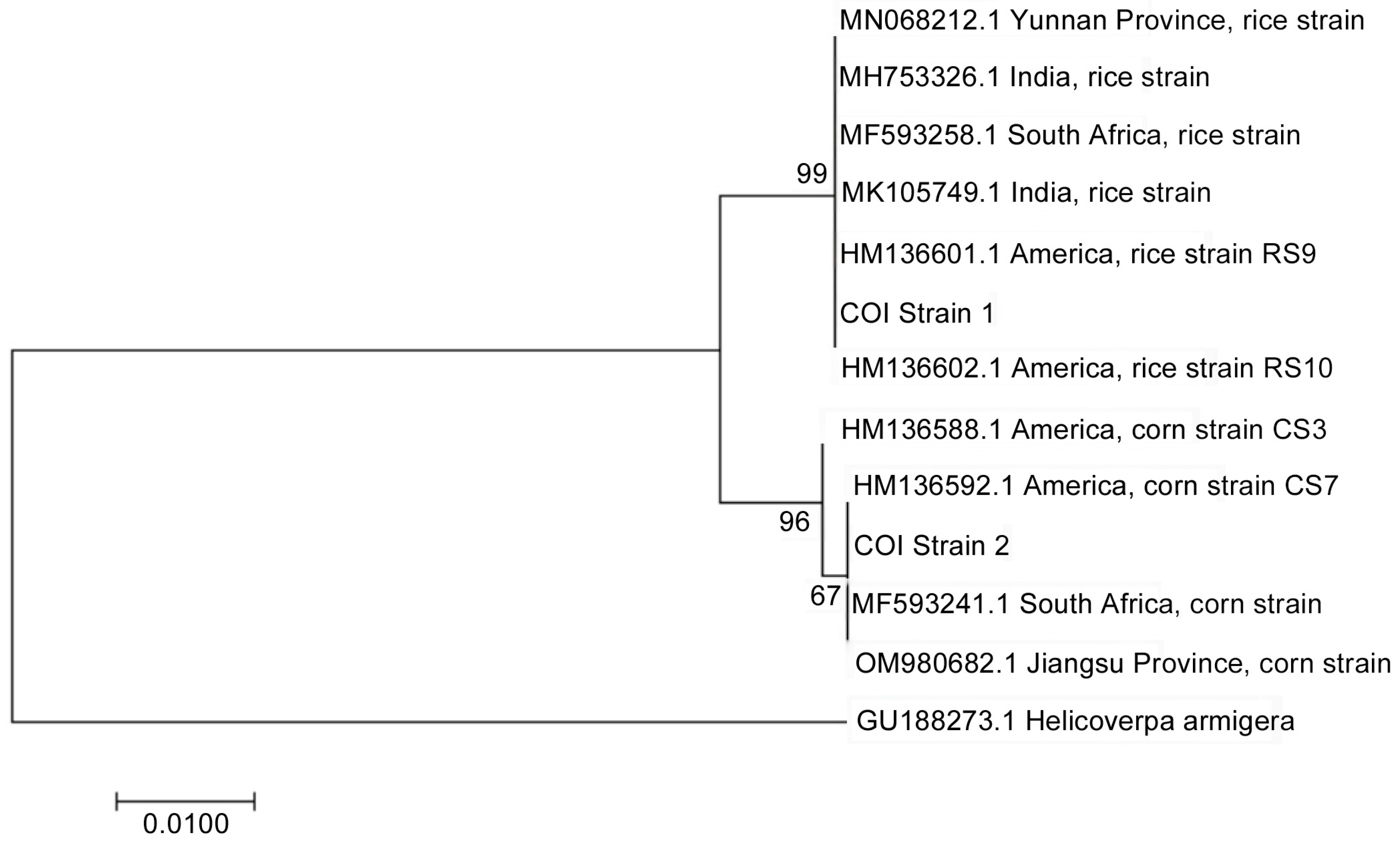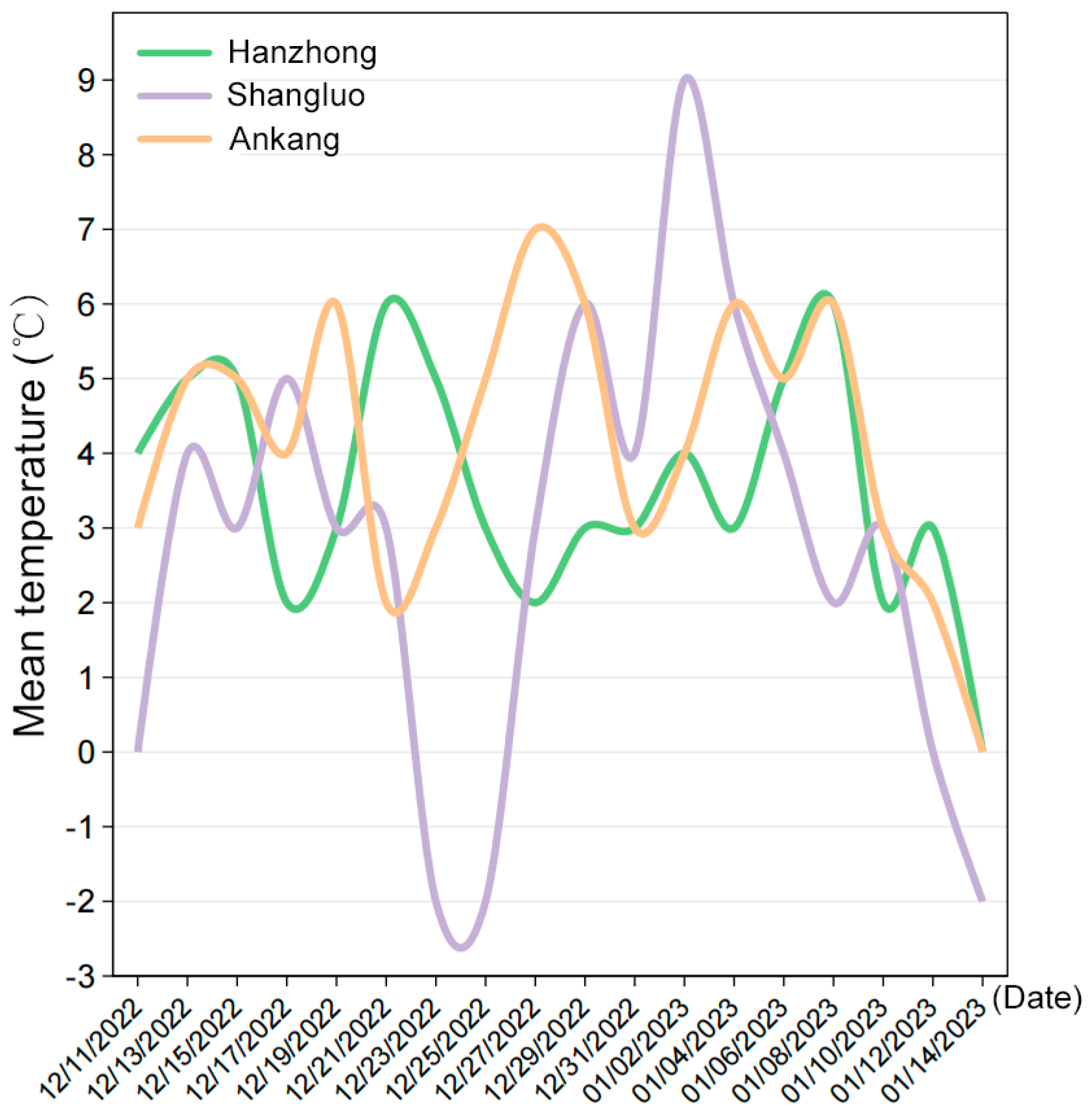Invasion Dynamics and Migration Patterns of Fall Armyworm (Spodoptera frugiperda) in Shaanxi, China
Simple Summary
Abstract
1. Introduction
2. Materials and Methods
2.1. Survey of FAW Initial Infestation in Shaanxi
2.2. Simulation of FAW Invasion Routes in Shaanxi
2.3. Genetic Characterization of FAW Populations from Different Geographical Regions
2.4. Preliminary Investigation of FAW Pupal Overwintering in Shaanxi
3. Results
3.1. Initial Occurrence of FAW in Shaanxi from 2019 to 2023
3.2. Simulation of FAW Migration Trajectories in Shaanxi
3.3. Molecular Characterization of FAW Biotypes from Different Geographical Populations
3.4. Preliminary Investigation of FAW Overwintering in Shaanxi
4. Discussion
5. Conclusions
Supplementary Materials
Author Contributions
Funding
Data Availability Statement
Conflicts of Interest
Abbreviations
| FAW | Fall armyworm |
| AGL | Above ground level |
References
- Sparks, A.N. A review of the biology of the fall armyworm. Fla. Entomol. 1979, 62, 82–87. [Google Scholar] [CrossRef]
- Day, R.; Abrahams, P.; Bateman, M.; Beale, T.; Clottery, V.; Cock, M.; Colmenarez, Y.; Corniani, N.; Early, R.; Godoin, J.; et al. Fall armyworm: Impacts and implications for Africa. Outlooks Pest Manag. 2017, 28, 196–201. [Google Scholar] [CrossRef]
- Wu, Q.L.; He, L.M.; Shen, X.J.; Jiang, Y.Y.; Liu, J.; Hu, G.; Wu, K.M. Estimation of the potential infestation area of newly-invaded fall armyworm Spodoptera frugiperda in the Yangtze River Valley of China. Insects 2019, 10, 298. [Google Scholar] [CrossRef]
- Johnson, C.G. Migration and Dispersal of Insects by Flight; Methuen & Co., Ltd.: London, UK, 1969. [Google Scholar]
- Chapman, J.W.; Reynolds, D.R.; Wilson, K. Long-range seasonal migration in insects: Mechanisms, evolutionary drivers and ecological consequences. Ecol. Lett. 2015, 18, 287–302. [Google Scholar] [CrossRef] [PubMed]
- Westbrook, J.K.; Nagoshi, R.N.; Meagher, R.L.; Jiang, Y.Y.; Liu, J.; Hu, G.; Wu, K.M. Modeling seasonal migration of fall armyworm moths. Int. J. Biometeorol. 2016, 60, 255–267. [Google Scholar] [CrossRef]
- Early, R.; González-Moreno, P.; Murphy, S.T.; Day, R. Forecasting the global extent of invasion of the cereal pest Spodoptera frugiperda, the fall armyworm. NeoBiota 2018, 40, 25–50. [Google Scholar] [CrossRef]
- Prasanna, B.M.; Huesing, J.E.; Eddy, R.; Peschke, V.M. Fall Armyworm in Africa: A Guide for Integrated Pest Management; CIMMYT: Texcoco, Mexico, 2018. [Google Scholar]
- Li, X.J.; Wu, M.F.; Ma, J.; Gao, B.Y.; Wu, Q.L.; Chen, A.D.; Liu, J.; Jiang, Y.Y.; Zhai, B.P.; Early, R.; et al. Prediction of migratory routes of the invasive fall armyworm in eastern China using a trajectory analytical approach. Pest Manag. Sci. 2020, 76, 454–463. [Google Scholar] [CrossRef] [PubMed]
- Jiang, Y.Y.; Liu, J.; Xie, M.C.; Li, Y.H.; Yang, J.J.; Zhang, M.L.; Qiu, K. Observation on law of diffusion damage of Spodoptera frugiperda in China with 2019. Plant Prot. 2019, 45, 10–19. [Google Scholar] [CrossRef]
- Chen, R.; Jiang, L.Y.; Chen, J.; Qiao, G.X. DNA barcoding reveals a mysterious high species diversity of conifer-feeding aphids in the mountains of southwest China. Sci. Rep. 2020, 10, 1–13. [Google Scholar] [CrossRef]
- Ren, H.Y.; Gui, W.Y.; Bai, Y.F. Long-term effects of grazing and topography on extra-radical hyphae of arbuscular mycorrhizal fungi in semi-arid grasslands. Mycorrhiza 2018, 28, 117–127. [Google Scholar] [CrossRef]
- Goergen, G.; Kumar, P.L.; Sankung, S.B.; Togola, A.; Tamò, M. First report of outbreaks of the fall armyworm Spodoptera frugiperda (JE Smith) (Lepidoptera, Noctuidae), a new alien invasive pest in West and Central Africa. PLoS ONE 2016, 11, e0165632. [Google Scholar] [CrossRef] [PubMed]
- Stein, A.F.; Draxler, R.R.; Rolph, G.D.; Stunder, B.J.B.; Cohen, M.D.; Ngan, F. NOAA’s HYSPLIT atmospheric transport and dispersion modeling system. Bull. Am. Meteorol. Soc. 2015, 96, 2059–2077. [Google Scholar] [CrossRef]
- Reynolds, A.M.; Reynolds, D.R.; Sane, S.P.; Hu, G.; Chapman, J.W. Orientation in high-flying migrant insects in relation to flows: Mechanisms and strategies. Philos. Trans. R. Soc. B Biol. Sci. 2016, 371, 20150382. [Google Scholar] [CrossRef]
- Alerstam, T.; Chapman, J.W.; Backman, J.; Smith, A.D.; Karlsson, H.; Nilsson, C.; Reynolds, D.R.; Klaassen, R.H.G.; Hill, J.K. Convergent patterns of long-distance nocturnal migration in noctuid moths and passerine birds. Proc. R. Soc. B Biol. Sci. 2011, 278, 2524–2530. [Google Scholar] [CrossRef]
- Wu, Q.L.; Jang, Y.Y.; Liu, Y.; Liu, J.; Ma, J.; Hu, G.; Yang, M.J.; Wu, K.M. Migration Pathway of Spodoptera frugiperda in Northwestern China. Sci. Agric. Sin. 2022, 55, 1949–1960. [Google Scholar] [CrossRef]
- Wu, Q.L.; Shen, X.J.; He, L.M.; Jiang, Y.Y.; Liu, J.; Hu, G.; Wu, K.M. Windborne migration routes of newly-emerged fall armyworm from Qinling Mountains-Huaihe River region, China. J. Integr. Agric. 2021, 20, 694–706. [Google Scholar] [CrossRef]
- Zhang, L.; Jin, M.H.; Zhang, D.D.; Jiang, Y.Y.; Liu, Y.Y.; Wu, K.M.; Xiao, Y.T. Molecular identification of invasive fall armyworm Spodoptera frugiperda in Yunnan Province of China. Plant Prot. 2019, 45, 19–24. [Google Scholar] [CrossRef]
- Kearse, M.; Moir, R.; Wilson, A.; Stones-Havas, S.; Cheung, M.; Sturrock, S.; Buxton, S.; Cooper, A.; Markowitz, S.; Duran, C.; et al. Geneious Basic: An integrated and extendable desktop software platform for the organization and analysis of sequence data. Bioinformatics 2012, 28, 1647–1649. [Google Scholar] [CrossRef] [PubMed]
- Kumar, S.; Stecher, G.; Li, M.; Knyaz, C.; Tamura, K. MEGA X: Molecular Evolutionary Genetics Analysis across computing platforms. Mol. Biol. Evol. 2018, 35, 1547–1549. [Google Scholar] [CrossRef]
- Li, G.P.; Liu, B.; Sun, X.; Huang, J.R.; Qiu, F.; Feng, H.Q. Field evaluation of Bt corn expressing cry1A.105+cry2Ab2+cp4epsps against Lepidoptera pests and tolerance to glyphosate. Plant Prot. 2019, 45, 142–147. [Google Scholar] [CrossRef]
- IBM Corp. IBM SPSS Statistics for Windows, Version 27.0; IBM Corp.: Armonk, NY, USA, 2020.
- Wang, L.; Chen, K.W.; Zhong, G.H.; Xiao, J.D.; He, X.F.; Lu, Y.Y. Progress for occurrence and management and the strategy of the fall armyworm Spodoptera frugiperda (Smith). J. Econ. Entomol. 2019, 41, 479–487. [Google Scholar] [CrossRef]
- Yang, P.Y.; Zhu, X.M.; Guo, J.F.; Wang, Z.Y. Strategy and advice for managing the fall armyworm in China. Plant Prot. 2019, 45, 1–6. [Google Scholar] [CrossRef]
- Jing, D.P.; Guo, J.F.; Jiang, Y.Y.; Zhao, J.Z.; Sehi, A.; He, K.L.; Wang, Z.Y. Initial detections and spread of invasive Spodoptera frugiperda in China and comparisons with other noctuid larvae in cornfields using molecular techniques. Insect Sci. 2020, 27, 780–790. [Google Scholar] [CrossRef] [PubMed]
- Yang, J.J.; Guo, Z.P.; Luo, H.G.; Jiang, Y.Y.; Huang, J.X.; Zhang, K.X.; Liu, Q.; Yuan, H. Research on the law of infestation and monitoring technology of Spodoptera frugiperda in Hubei province in 2019. Plant Prot. 2020, 46, 247–253. [Google Scholar] [CrossRef]
- Guo, J.F.; Zhao, J.Z.; He, K.L.; Zhang, F.; Wang, Z.Y. Potential invasion of the crop-devastating insect pest fall armyworm Spodoptera frugiperda to China. Plant Prot. 2019, 44, 1–10. [Google Scholar] [CrossRef]
- Jia, H.R.; Guo, J.L.; Wu, Q.L.; Hu, C.X.; Li, X.K.; Zhou, X.Y.; Wu, K.M. Migration of invasive Spodoptera frugiperda (Lepidoptera: Noctuidae) across the Bohai Sea in northern China. J. Integr. Agric. 2021, 20, 685–693. [Google Scholar] [CrossRef]
- Lu, Y.H.; Wu, K.M.; Jiang, Y.Y.; Guo, Y.Y.; Desneux, N. Widespread adoption of Bt cotton and insecticide decrease promotes biocontrol services. Nature 2013, 487, 362–365. [Google Scholar] [CrossRef]
- Sun, X.X.; Hu, C.X.; Jia, H.R.; Wu, Q.L.; Shen, X.J.; Zhao, S.Y.; Jiang, Y.Y.; Wu, K.M. Case study on the first immigration of fall armyworm, Spodoptera frugiperda invading into China. J. Integr. Agric. 2021, 20, 664–672. [Google Scholar] [CrossRef]
- Zhang, L.; Liu, B.; Liu, C.; Zhang, D.D.; Zhao, S.Y.; Li, Z.Y.; Xu, P.J.; Wilson, K.; Withers, A.; Jones, C.M. Genetic structure and insecticide resistance characteristics of fall armyworm populations invading China. Mol. Ecol. Resour. 2020, 20, 1682–1696. [Google Scholar] [CrossRef]
- Tan, S.Q.; Wang, Z.X.; He, J.X.; Ma, Z.N.; Yin, L.; Zhang, Z.B.; Zhang, Y.S. Analysis of the migration path and source areas of fall armyworm Spodoptera frugiperda in Hunan Province in 2021. J. Plant Prot. 2024, 51, 132–140. [Google Scholar] [CrossRef]
- Wang, R.L.; Jiang, C.X.; Guo, X.; Chen, D.D.; Chao, Y.; Zhang, Y.; Wang, M.T.; Li, Q. Potential distribution and genetic diversity of fall armyworm in China. Glob. Ecol. Conserv. 2020, 21, e00865. [Google Scholar] [CrossRef]
- Jiang, C.X.; Zhang, X.Y.; Xie, W.Q.; Wang, R.L.; Feng, C.H.; Ma, L.; Li, Q.; Yang, Q.F.; Wang, H.J. Predicting the potential distribution of the fall armyworm Spodoptera frugiperda (J.E. Smith) under climate change in China. Glob. Ecol. Conserv. 2022, 33, e01994. [Google Scholar] [CrossRef]



| Sample No. | Collection | Collection Time | Host | Stage | Number of Samples |
|---|---|---|---|---|---|
| 1 | Baoji, Shaanxi Province (107°96′ E, 34°48′ N) | 10/12/2023 | Corn | larvae | 13 |
| 2 | Hanzhong, Shaanxi Province (107°12′ E, 34°48′ N) | 7/20/2023 | Corn | larvae | 13 |
| 3 | Ankang, Shaanxi Province (109°86′ E, 36°66′ N) | 7/23/2023 | Corn | larvae | 7 |
| 4 | Ankang, Shaanxi Province (109°26′ E, 32°52′ N) | 8/28/2023 | Corn | larvae | 6 |
| 5 | Ruili, Yunnan Province (97°49′ E, 23°58′ N) | 4/25/2023 | Corn | larvae | 8 |
| 6 | Xinxiang, Henan Province (114°08′ E, 32°10′ N) | 7/5/2023 | Corn | larvae | 12 |
| 7 | Shangluo, Shaanxi Province (110°21′ E, 34°01′ N) | 8/3/2023 | Corn | larvae | 13 |
| 8 | Wuhan, Hubei Province (114°06′ E, 30°34′ N) | 6/30/2023 | Corn | larvae | 11 |
| 9 | Xi’an, Shaanxi Province (109°08′ E, 34°25′ N) | 9/7/2022 | Corn | larvae | 10 |
| 10 | Hanzhong, Shaanxi Province (106°55′ E, 32°09′ N) | 7/21/2022 | Corn | larvae | 7 |
| 11 | Shangluo, Shaanxi Province (110°30′ E, 33°59′ N) | 8/1/2022 | Corn | larvae | 6 |
| 12 | Ankang, Shaanxi Province (108°36′ E, 32°50′ N) | 7/26/2022 | Corn | larvae | 7 |
| Survey Year | County | Initial Occurrence Date | Occurrence Area (mu) | Average Rate of Damaged Plants (%) | Average Larval Number per 100 Plants | Larval Instar | Estimated Immigration Date |
|---|---|---|---|---|---|---|---|
| 2019 | Yangxian (107°44′ E, 33°07′ N) | 31 May | 0.37 | 7.1 | 3 | 2–4 | 21 May |
| 2020 | Zhenping (109°26′ E, 31°51′ N) | 28 June | 40 | 7 | 15 | 1–4 | 15 June |
| 2021 | Chenggu (107°11′ E, 33°27′ N) | 22 June | 7 | 2.6 | 4 | 3–5 | 8 June |
| 2022 | Ningqiang (106°03′ E, 33°57′ N) | 11 July | 3.7 | 2.29 | 2 | 2–4 | 28 June |
| 2023 | Mian (106°54′ E, 33°09′ N) | 20 June | 1.2 | 1.08 | 2 | 2–5 | 1 June |
| Sample No. | Collect Locations | COI Maker | Tpi Maker | ||
|---|---|---|---|---|---|
| Corn Strain | Rice Strain | Corn Strain | Rice Strain | ||
| 1 | Baoji, Shaanxi Province | 4 | 9 | 13 | 0 |
| 2 | Hanzhong, Shaanxi Province | 0 | 13 | 13 | 0 |
| 3 | Ankang, Shaanxi Province | 0 | 7 | 7 | 0 |
| 4 | Xianyang, Shaanxi Province | 2 | 4 | 6 | 0 |
| 5 | Ruili, Yunnan Province | 0 | 8 | 8 | 0 |
| 6 | Xinxiang, Henan Province | 7 | 5 | 12 | 0 |
| 7 | Shangluo, Shaanxi Province | 4 | 9 | 13 | 0 |
| 8 | Wuhan, Hubei Province | 0 | 11 | 11 | 0 |
| 9 | Xi’an, Shaanxi Province | 0 | 10 | 10 | 0 |
| 10 | Hanzhong, Shaanxi Province * | 0 | 7 | 7 | 0 |
| 11 | Shangluo, Shaanxi Province * | 0 | 6 | 6 | 0 |
| 12 | Ankang, Shaanxi Province * | 0 | 7 | 7 | 0 |
| Collect Locations | Survival Rates (%) of Pupae at Different Dates | ||||||
|---|---|---|---|---|---|---|---|
| 15 December | 20 December | 25 December | 30 December | 4 January | 9 January | 14 January | |
| Hanzhong | 100 ± 0.00 a | 95.55 ± 1.11 a | 83.33 ± 1.92 ab | 61.11 ± 2.94 ab | 36.67 ± 1.93 ab | 16.67 ± 1.93 a | 0 |
| Ankang | 98.89 ± 1.11 a | 96.67 ± 1.93 a | 87.78 ± 1.11 a | 64.59 ± 1.04 ab | 37.78 ± 1.11 ab | 6.67 ± 3.84 a | 0 |
| Shngluo | 98.89 ± 1.11 a | 88.89 ± 1.11 b | 72.22 ± 1.11 c | 55.55 ± 4.01 b | 31.11 ± 2.22 ab | 7.78 ± 1.14 a | 0 |
Disclaimer/Publisher’s Note: The statements, opinions and data contained in all publications are solely those of the individual author(s) and contributor(s) and not of MDPI and/or the editor(s). MDPI and/or the editor(s) disclaim responsibility for any injury to people or property resulting from any ideas, methods, instructions or products referred to in the content. |
© 2025 by the authors. Licensee MDPI, Basel, Switzerland. This article is an open access article distributed under the terms and conditions of the Creative Commons Attribution (CC BY) license (https://creativecommons.org/licenses/by/4.0/).
Share and Cite
Yan, Z.; Feng, X.; Wang, X.; Yuan, X.; Zhang, Y.; Yang, D.; He, K.; Xie, F.; Wang, Z.; Li, Y. Invasion Dynamics and Migration Patterns of Fall Armyworm (Spodoptera frugiperda) in Shaanxi, China. Insects 2025, 16, 620. https://doi.org/10.3390/insects16060620
Yan Z, Feng X, Wang X, Yuan X, Zhang Y, Yang D, He K, Xie F, Wang Z, Li Y. Invasion Dynamics and Migration Patterns of Fall Armyworm (Spodoptera frugiperda) in Shaanxi, China. Insects. 2025; 16(6):620. https://doi.org/10.3390/insects16060620
Chicago/Turabian StyleYan, Zhanfeng, Xiaojun Feng, Xing Wang, Xiangqun Yuan, Yongjun Zhang, Daibin Yang, Kanglai He, Feizhou Xie, Zhenying Wang, and Yiping Li. 2025. "Invasion Dynamics and Migration Patterns of Fall Armyworm (Spodoptera frugiperda) in Shaanxi, China" Insects 16, no. 6: 620. https://doi.org/10.3390/insects16060620
APA StyleYan, Z., Feng, X., Wang, X., Yuan, X., Zhang, Y., Yang, D., He, K., Xie, F., Wang, Z., & Li, Y. (2025). Invasion Dynamics and Migration Patterns of Fall Armyworm (Spodoptera frugiperda) in Shaanxi, China. Insects, 16(6), 620. https://doi.org/10.3390/insects16060620







